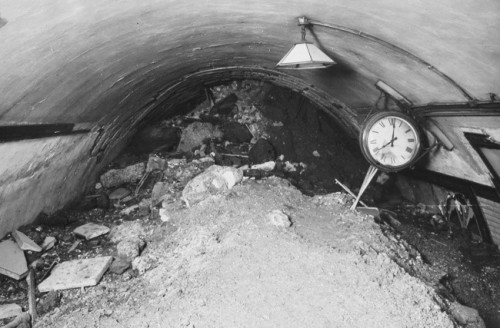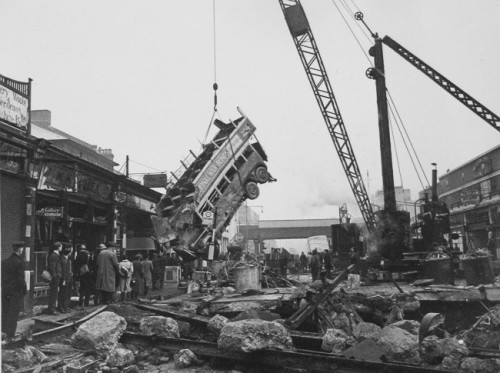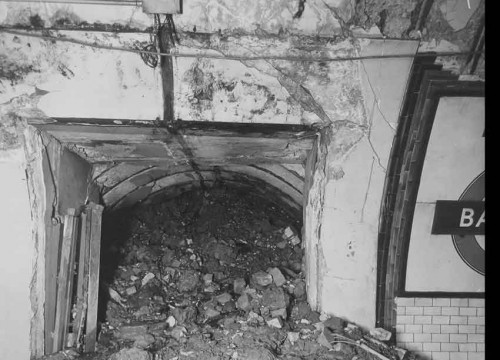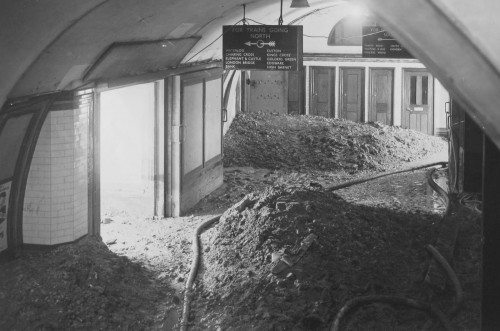It’s the evening of 14th October 1940, and one of the worst wartime disasters of the London Underground is about to take place.
German bombers were overhead and people had taken to the shelters, including the platforms at Balham underground station. The trains would have still been running at the time, and commuters would have been stepping over people using the station for protection.
Although just 13 metres below ground, the platforms were considered deep enough to be classed as an official shelter point.
At exactly 2 minutes past 8pm, a bomb hit the road above, causing a massive crater in the ground, and fracturing a water mains below ground. The subsequent flood of water and soil into the tunnel was to kill nearly 70 people.
The exact number of dead is unclear, with reports ranging from 64 to 68 people, although the Commonwealth War Graves Commission now officially records 66 deaths.
In addition, more than 70 people were injured.
What is certain though is when the bomb struck, as the clock on the underground platform stopped at exactly 8:02pm.
In addition to the deaths and injuries below ground, one of the more famous images of the disaster is from above ground, as a bus plunged into the freshly formed crater, causing more injuries, although of a generally minor nature.
A pathe news clip of the scene the following day is here.
Down below ground though, the crater had struck right above a cross passage between the two platforms. Had that been the end of the matter, then the death toll would have been far lower. The debris filled the short corridor, but would have come to a swift end under its own weight.
However, a water mains pipe also broke, and there are few forces in nature as powerful as water for shifting vast quantities of soil.
“The water main was burst and the flood rolled down the tunnels, right up and down the line, and the thousands of refugees were plunged into darkness, water. They stood, trapped, struggling, panicking in the rising black invisible waters.” Colin Perry.
Colin was recounting how the disaster was told to him later, and there was certainly some embellishment going on. For a start, there’s no way that thousands of people could have been in the station. Other references to gas seem disputed, although a gas mains was broken. But, such is the nature of rumours and gossip.
At the time, rumour and gossip was already talking about hundreds of dead, but an inspection by Lt-Col. AHL Mount, the Chief Inspecting Officer of Railways at the Ministry of Transport the following day dismissed that as exaggerated.
His report gives a graphic insight into the aftermath of the disaster, as the fire brigade was still pumping water out the following day, and one of the three broken water mains was draining “into the crater like a small waterfall.”
Thanks to the subsidence below ground, the crater above ground was considerably enlarged, to having a diameter of some 60-70 feet. Along with the bus, it became a powerful image of the war, and it wasn’t until after the war that photos of the devastation inside were released.
It was to take several months to clear the site, with bodies still being recovered in late December.
The line, which had been suspended between Tooting Bec and Clapham Common was reopened on the 8th January 1941, with the station reopening on the 19th January.
In 2000, a memorial plaque was placed in the entrance hall to the station in memory of those who died. In 2010 the plaque was replaced with a version removing the number of those who died, due to the uncertainty about that number. The original plaque is now in the London Transport Museum.
Recently, the flooding of the station during the disaster was featured, with some degree of artistic license, in the film Atonement, with the flooding scene filmed on an impressive scale model of the station.











As a child of five years, and living about three streets away, I remember that night! However my family and others were in an Anderson shelter. dug by my father as ordered by the government. The people down the tubes weren’t so lucky that night”. I didn’t know how many were killed, but I learned that it was an incendry bomb that hit the water mains and everyone who was down there drowned. I guess that wasn’t quite correct. My family was bombed out, on a street in Balham. We lost everything, and from there on we moved from one place to another by the orders of the Government. We were very fortunate. We survived, but the memories also have survived. I will always remember how those who lived through it all, clubbed together and took care of each other. I wish that could apply now in 2017! Thank you Colin Perry for your knowledge and experience,and post.
My Dad and Gramp were on bombe= damage during the war as dad was to young to fight and gramp was gased in the 1st WW..Dad said it was a land mine that smashed through the roof of the tube exploding underground with lots drowning and crushed in the panic to get out..They eventually realised the water was from the river graveney that is piped underground which broke and filled the station…They dug up tooting bec common and dammed the river to enable the water to be pumped out but bits of bodies and debris blocked the pumps so they put quicklime into the water to dissolve the body parts then pumped successfully….My Mum who lived down the botom of bedford hill above the sunlight laundry went to school nearby usually went down the tube with me gran and brothers, this night me uncle Stan had an Asthma attack and me gran said they should sleep under the kitchen table…next morning me Mum went to schoolas usual with the class sent home after the teacher read the register with the kids and teacher all crying by the time she finished realising all the kids that were killed (Murdered)..
My husband’s family used to travel from the Elephant and Castle to Balham every night. That night my mother in law and my six year old sister in law were outraged to discover that their ” place” had been pinched by someone else. They travelled on to the next station. All the rest of the family- granny, aunties cousins etc were killed.
My husband was born after the war – the incident haunted my mother in law until the day she died.
My Mum ,Aunt Nan and Uncle were down there and by the grace of God managed to get out, I remember mum saying that she didn’t have a stitch on when she got to the surface and the sally army gave her a blanket, it was several months after that a warden arrived at her front door with a handbag saying how sorry he was about her lose, my mum informed him that her family were all safe and lucky to be alive. Many years later the BBC made a doumentary and that was the first time mum had been down into the Tube since 1940.
thank you for these fascinating accounts.
My uncle was outside the tube that day and I would love to hear about more accounts or any other social history you may have.
my dad John Oram age 9 at the time, was with his mother Mary Oram, Aunt Amelia Lancaster and children, down there on that fateful night.
Dad has dementia now aged 89 but his recollections of how they managed to survive are as strong as in 1940. He recalls that they were bedded down for the night and the station master had locked the gates by the escalators to stop others coming down for overcrowding and not to disturb those bedded down. He says it was all panic when they realised water was coming fast and the station master with the keys had been killed in the blast.
Dad and another small lad were grabbed to see if they could squeeze through a small gap at the bottom of the gates where they didn’t close fully, dad says they tried him first but his head was too big so the tiny lad was pushed through and in dads words, ~”I don’t know how the little blighter got through and up the wooden escalators that was, they were blown to bits nothing left but firewood, he managed to get help and soon after the ARP got down to us and opened the gates, then the panic began, I was thrown up onto what was left of the escalators, wooden in them days, and told to get a move on quick…. ”
Dad recalls that when they reached the top the children were marched to a shelter in a line, “we did as we were told in them days and later my mother found me there… the next day or so we were packed of to Dearham in Norfolk where my half sister lived as her husband had just come back from Dunkirk and was stationed in norfolk. We were found a safe house for a while and stayed there until we could return to middlesex.””
“I still don’t no how we escaped as the water and debris was over the electric wires which were exposed…… we were very lucky…… ”
Dad is very emotional as he recalls that day but smiles once told and recovered and feels very lucky to have lived to tell the tale. He never did go back to school, but went to Malaya in the Korean peace war as a young 18 year old and learnt how to cut hair on the ship Ocadia on the 6 week journey out there over xmas 1949 and made his living when he returned home as a barber, only retiring when he was 80 when mum was housebound and he had to help look after her….. he’s as tough as old boots been through a lot but still feels lucky…. bless
That’s an incredible and moving story. Thank you for writing it down.
I was 4 and evacuated at the time but I remember seeing the high tidemark on the wall of the station platform when it opened.
My mum and I slept on the platform when the raids were bad. I recall the sound of the last train at night. I remember the organised singing